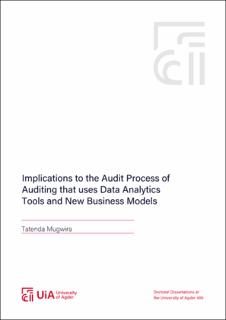| dc.contributor.advisor | Stuart, Iris Caroline | |
| dc.contributor.author | Mugwira, Tatenda | |
| dc.date.accessioned | 2023-04-18T12:07:12Z | |
| dc.date.available | 2023-04-18T12:07:12Z | |
| dc.date.created | 2023-04-17T14:21:45Z | |
| dc.date.issued | 2023 | |
| dc.identifier.citation | Mugwira, T. (2023). Implications to the Audit Process of Auditing that uses Data Analytics Tools and New Business Models [Doctoral dissertation]. University of Agder. | en_US |
| dc.identifier.isbn | 978-82-8427-118-7 | |
| dc.identifier.issn | 1504-9272 | |
| dc.identifier.uri | https://hdl.handle.net/11250/3063578 | |
| dc.description | Paper II is excluded from the dissertation until it is published. | |
| dc.description.abstract | New advances in information technology have created a wave of technological innovations which affect the audit firms. Audit firms are now investing large sums of money to acquire and adopt data analytics tools. Using three studies in this dissertation, I investigated questions relating to the impact of digital tools in the audit process. These studies are briefly summarized below. The first study investigates whether the audit evidence from a process mining tool provides information that adds to the appropriateness (relevance) of the audit evidence collected by traditional analytical procedures. The results shows that auditors do perceive evidence from a process mining tool to express information that is relevant for both the planning and substantive stages of the audit even though the auditor’s risk assessment was higher in the substantive stage as compared to the planning stage. In addition, the results also shows that there was no difference in the auditor’s assessment of the relevance of the information presented in graph format and in written text format as both are considered equally relevant in the planning and substantive stages. The second study investigates the unintended consequences in auditor’s decision making of using digital tools with powerful visualization abilities in the audit process. Specifically, the study investigates whether auditors make their decisions based on the relevance of the information to the decision to be made when using both visual audit evidence and text evidence or their decision will be based on a bias. The results shows that when auditors are presented with different information presented in different formats (visual or text), they are most likely to use the piece of information presented in visual rather than using the piece of audit evidence which is relevant to the decision. The third paper analyses the fraud case of a financial technology company Wirecard using the fraud triangle as the theoretical framework. The results shows that of the three factors identified in the fraud triangle, opportunity was the most prevalent factor and rationalization was least observable. | en_US |
| dc.language.iso | eng | en_US |
| dc.publisher | University of Agder | en_US |
| dc.relation.ispartofseries | Doctoral Dissertations at the University of Agder; no. 405 | |
| dc.relation.haspart | Paper I: Mugwira, T., Stuart, I., Kulset, E. & Nipper, M. (Forthcoming). The use of process mining in assessing the risk of material misstatement during an audit : Experimental evidence. Auditing, A Journal of Practice and Theory. Submitted version. Full-text is not available in AURA as a separate file. | en_US |
| dc.relation.haspart | Paper II: Mugwira, T. (Forthcoming). The unintended consequences of visual output from Audit Data Analytics tools on junior auditors’ professional judgments : Investigating the availability bias. Submitted version. Full-text is not available in AURA as a separate file. | en_US |
| dc.relation.haspart | Paper III: Mugwira, T. & Stuart, I. (Forthcoming). Fraud detection in the New Economy: Understanding digital fraud in Wirecard. Accounting Auditing and Accountability Journal. Submitted version. Full-text is not available in AURA as a separate file. | en_US |
| dc.rights | Attribution-NonCommercial-NoDerivatives 4.0 Internasjonal | * |
| dc.rights.uri | http://creativecommons.org/licenses/by-nc-nd/4.0/deed.no | * |
| dc.title | Implications to the Audit Process of Auditing that uses Data Analytics Tools and New Business Models | en_US |
| dc.type | Doctoral thesis | en_US |
| dc.description.version | publishedVersion | en_US |
| dc.rights.holder | © 2023 Tatenda Mugwira | en_US |
| dc.subject.nsi | VDP::Samfunnsvitenskap: 200::Økonomi: 210::Bedriftsøkonomi: 213 | en_US |
| dc.source.pagenumber | 134 | en_US |
| dc.source.issue | 405 | en_US |
| dc.identifier.cristin | 2141321 | |

